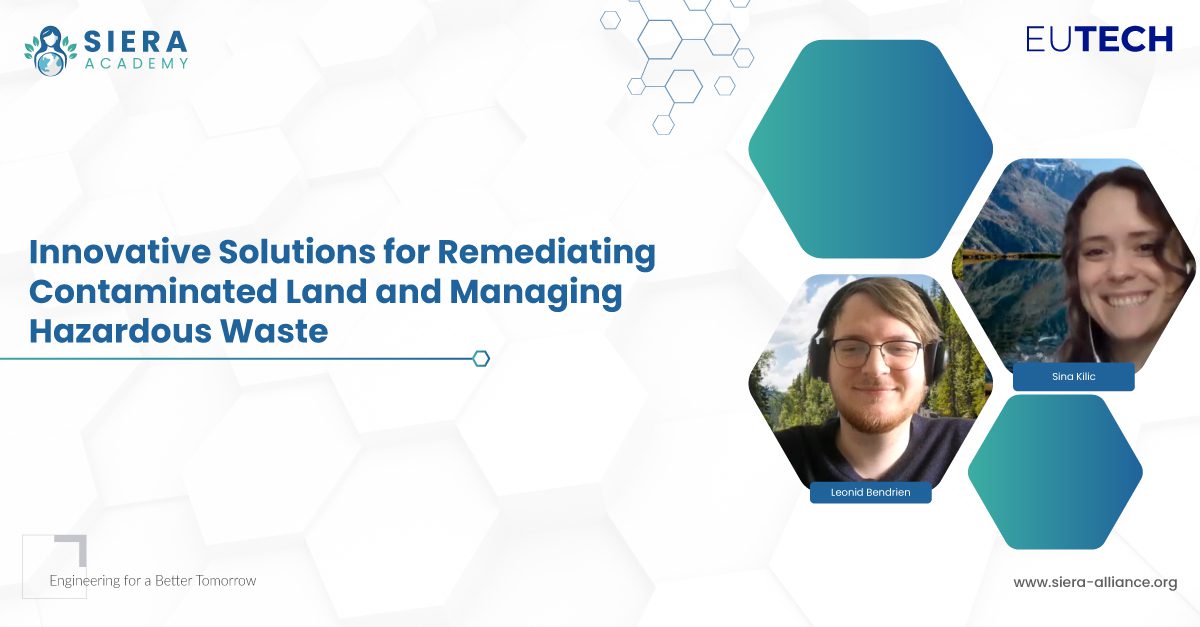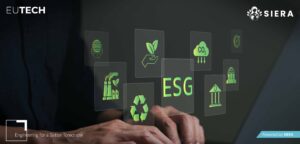Transforming Contaminated Sites into Sustainable Assets
Contaminated land and hazardous waste management are critical challenges that impact not only the environment but also public health and business sustainability. As the demand for sustainability grows, so does the need for effective and compliant solutions. On April 17, 2025, the SIERA Academy Impact Series Webinar, titled “Innovative Solutions for Remediating Contaminated Land and Managing Hazardous Waste,” provided a comprehensive overview of the current challenges in site remediation and showcased innovative technologies that are helping businesses reduce their environmental footprint while ensuring compliance with EU regulations.
The session, moderated by SIERA Alliance, focused on the growing importance of sustainable remediation and offered practical solutions for businesses dealing with contaminated sites. These solutions not only address environmental risks but also enhance ESG compliance, aligning with international standards like CSRD and ESRS.
The Challenge: Risks and Impact of Contaminated Sites
Contaminated sites are widespread, with an estimated 2.8 million potentially contaminated sites in Europe alone. These sites are often remnants of industrial operations, mining, or agriculture, leaving behind hazardous substances like heavy metals, hydrocarbons, and pesticides that have long-lasting effects on the environment and human health.
Environmental Risks of Contaminated Sites:
- Soil Degradation: Contaminants like lead, arsenic, and mercury reduce soil fertility and restrict land usability for agriculture or development.
- Water Pollution: Contaminated sites risk polluting groundwater and surface waters, compromising water quality and aquatic life.
- Biodiversity Loss: Pollution can destroy habitats, causing species decline and reducing ecosystem services.
- Public Health Hazards: Exposure to contaminated land can lead to serious health issues, including cancer, neurological damage, and respiratory diseases.
Contaminated land can significantly lower property values, increase legal liabilities, and pose long-term environmental risks, which makes addressing these challenges essential for business continuity and regulatory compliance.
Regulatory Landscape: The Need for Compliance and Reporting
The European Union has stringent regulations governing the remediation of contaminated land, primarily through the Waste Framework Directive, Environmental Liability Directive, and Water Framework Directive. Furthermore, businesses must comply with CSRD and ESRS, which require them to disclose environmental risks, including those from contaminated sites, and report on their remediation activities.
CSRD and ESRS compliance ensures that businesses are transparent in their environmental management efforts and are accountable for their actions. The EU Taxonomy for sustainable activities also encourages companies to integrate environmental risk management into their ESG strategies.
Key ESRS Standards for Remediation:
| ESRS Standard | Relevance to Contaminated Sites |
| E1: Climate Change | Identifies risks associated with climate-related contamination, such as flooding or drought exacerbating pollution. |
| E2: Pollution | Addresses toxic chemical pollution and hazardous waste management. |
| E3: Water | Ensures that groundwater and water bodies are protected from contamination during remediation. |
| E4: Biodiversity | Focuses on ecosystem restoration and the protection of natural habitats during remediation. |
| E5: Resource Use | Promotes resource efficiency and the reuse of materials during deconstruction and remediation processes. |
By aligning with these standards, businesses not only comply with regulatory requirements but also create value through sustainable practices that contribute to long-term environmental health.
Innovative Remediation Solutions: From Traditional Methods to Cutting-Edge Technologies
During the webinar, Keynote speaker presented a variety of innovative solutions that are transforming the way contaminated sites are managed. These solutions integrate traditional engineering methods with advanced technologies, allowing businesses to remediate efficiently, minimize waste, and ensure ESG compliance.
1. Environmental Site Assessments (ESA)
A thorough Environmental Site Assessment is the first step in any remediation project. It identifies the scope of contamination and helps to develop a targeted remediation plan. Using satellite imaging, groundwater sampling, and geophysical surveys, companies can evaluate the extent of contamination and make data-driven decisions.
- AI-Enhanced Data Processing: AI and machine learning can help interpret large datasets from remote sensing technologies and environmental sensors, providing insights into previously unknown contamination risks.
2. In-Situ Remediation: Bioremediation and Chemical Oxidation
In-situ remediation refers to techniques that treat contaminants at the site without removal. This approach is often more cost-effective and less disruptive.
- Bioremediation: Uses natural organisms, such as bacteria and fungi, to degrade pollutants in soil and water. It is particularly effective for hydrocarbon and agricultural chemical contamination.
- In-Situ Chemical Oxidation (ISCO): This technique involves injecting oxidizing agents into contaminated soil or groundwater to break down pollutants, especially for chlorinated solvents.
3. Ex-Situ Remediation: Soil Washing and Thermal Desorption
For highly contaminated sites, ex-situ remediation is often required.
- Soil Washing: Involves the use of water and chemicals to remove contaminants from the soil. This method is particularly effective for heavy metals and organic pollutants.
- Thermal Desorption: Uses high temperatures to vaporize contaminants from soil, a common method for volatile organic compounds (VOCs).
4. Sustain Suite: Real-Time Monitoring for Compliance Tracking
Sustain Suite, a comprehensive software tool developed by SIERA Alliance, enables businesses to track the progress of remediation efforts in real-time.
- Compliance Automation: The software integrates ESRS and CSRD reporting requirements, allowing businesses to monitor and report their remediation activities effectively.
- Impact Tracking: Predictive analytics integrated into the platform helps companies evaluate the environmental and social impact of their remediation efforts and adjust their strategies accordingly.
5. Electrochemical Desorption for PFAS Removal
Electrochemical desorption is an innovative technique for treating PFAS (Per- and Polyfluoroalkyl Substances) contamination, one of the most persistent pollutants. This method uses electrochemical reactions to remove PFAS from soil and water.
- Enhanced Recovery: Activated carbon modules with electrodes enhance the ability of the system to remove contaminants effectively, making it a viable option for large-scale remediation projects.
6. Phytoremediation: Harnessing Nature’s Power
Phytoremediation involves using plants to remove or neutralize contaminants from soil and water. Plants such as sunflowers and willows can absorb heavy metals and organic compounds, making this method an eco-friendly, low-cost solution for contaminated land.
- Carbon Sequestration: In addition to remediating soil, phytoremediation helps sequester carbon, contributing to climate adaptation goals.
7. Public Engagement and Stakeholder Collaboration
Public involvement is critical to the success of any remediation project. SIERA Alliance advocates for collaborative efforts between businesses, local communities, and environmental organizations to ensure that remediation plans meet both regulatory and social expectations.
- GIS Tools for Engagement: Geospatial tools like SustainSuite provide a platform for stakeholders to visualize remediation progress and provide feedback, ensuring transparency and community buy-in.
Case Study: Groundwater Protection Through Advanced PFAS Treatment
An innovative case study presented during the webinar was the PFAS Contamination Remediation Project funded by the Federal Ministry of Education and Research (BMBF) in Germany. This project demonstrates cutting-edge remediation technology for treating PFAS (Per- and Polyfluoroalkyl Substances), one of the most challenging contaminants to manage. The project used a combination of biopolymer-based in-situ PFAS elution and electrochemical desorption modules to successfully reduce PFAS concentrations in soil and water.
Key Project Details:
Technology Used:
- Biopolymer-Based PFAS Elution: The biopolymer interacts with PFAS, extracting them from contaminated soil. This method was shown to achieve up to 97% removal efficiency in contaminated sites.
- Electrochemical Desorption Modules: These modules, used for PFAS removal from water, achieved up to 99% removal efficiency, particularly effective for short-chain PFAS.
Pilot Testing: The project included multiple pilot tests across two sites in Southern and Northern Germany, demonstrating effective PFAS removal from soils and water.
- In Southern Germany, the PFAS soil load was reduced by 97%, primarily targeting PFDA (perfluorodecanoic acid).
- In Northern Germany, PFOS and PFUnA were treated successfully, showing significant reductions in contamination levels.
Results:
- High Removal Efficiency: The combined application of biopolymer-based elution and electrochemical desorption modules achieved significant contaminant removal, with reduced environmental impact and improved groundwater quality.
- Sustainability Impact: The project aligns with EU Taxonomy standards for sustainable remediation and supports ESG reporting in compliance with CSRD and ESRS frameworks.
This case study not only demonstrates the effectiveness of these advanced technologies in remediating PFAS contamination but also sets a precedent for future PFAS treatment projects in contaminated land management.
Take the Next Step with SIERA
At SIERA Alliance, we specialize in providing innovative solutions for contaminated land remediation and hazardous waste management. Our expertise in environmental risk management and ESG compliance helps businesses address legacy contamination, enhance sustainability, and ensure regulatory compliance.
Our services include:
- Environmental Site Assessments (ESA): Comprehensive site analysis to identify contamination and assess remediation needs.
- Innovative Remediation Solutions: Advanced methods like bioremediation, soil washing, and electrochemical desorption.
- Sustain Suite: Real-time monitoring and ESG reporting to track remediation efforts and ensure compliance. Book a free demo now.
- Public Engagement: Using GIS-based tools to enhance stakeholder collaboration and increase transparency.
Get in touch with SIERA Alliance today to explore how our innovative remediation solutions can help you address contaminated sites and hazardous waste. Our team of experts is ready to support you in implementing sustainable, regulatory-compliant strategies that not only protect the environment but also enhance your ESG performance and long-term business resilience.
Upcoming Events and Opportunities:
Stay updated on future events. For more insights and information on our upcoming SIERA Impact Series Webinars, explore the Event Calendar. Lear more and register for our free to join digital events.









